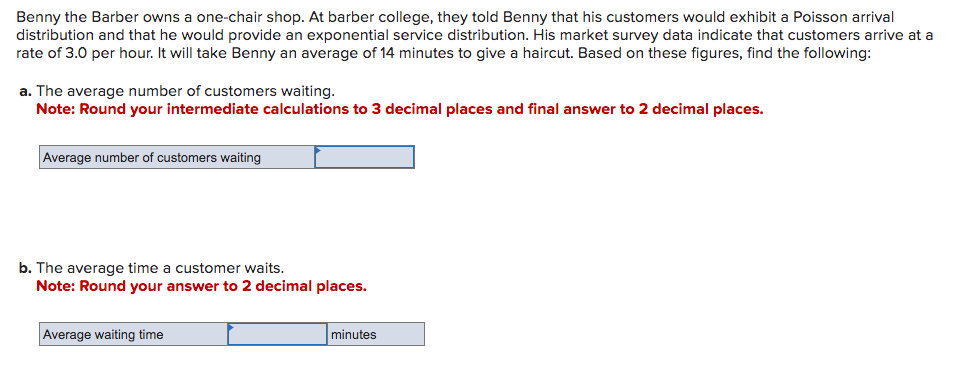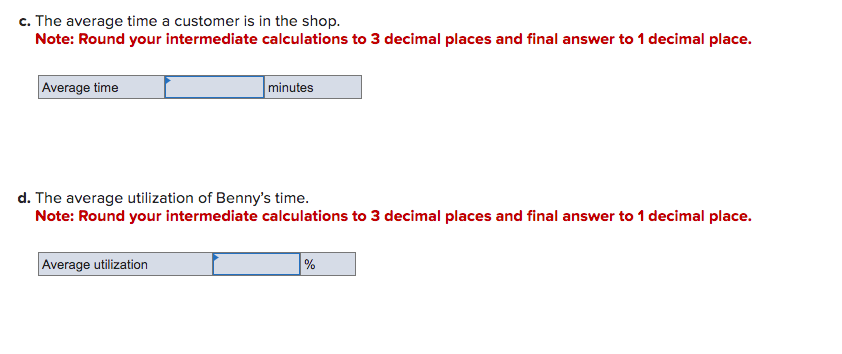Benny the Barber owns a one-chair shop. At barber college, they told Benny that his customers would exhibit a Poisson arrival distribution and that he would provide an exponential service distribution. His market survey data indicate that customers arrive at a rate of 3.0 per hour. It will take Benny an average of 14 minutes to give a haircut. Based on these figures, find the following: a. The average number of customers waiting. Note: Round your intermediate calculations to 3 decimal places and final answer to 2 decimal places. Average number of customers waiting b. The average time a customer waits. Note: Round your answer to 2 decimal places. Average waiting time minutes
Benny the Barber owns a one-chair shop. At barber college, they told Benny that his customers would exhibit a Poisson arrival distribution and that he would provide an exponential service distribution. His market survey data indicate that customers arrive at a rate of 3.0 per hour. It will take Benny an average of 14 minutes to give a haircut. Based on these figures, find the following: a. The average number of customers waiting. Note: Round your intermediate calculations to 3 decimal places and final answer to 2 decimal places. Average number of customers waiting b. The average time a customer waits. Note: Round your answer to 2 decimal places. Average waiting time minutes
Practical Management Science
6th Edition
ISBN:9781337406659
Author:WINSTON, Wayne L.
Publisher:WINSTON, Wayne L.
Chapter12: Queueing Models
Section12.5: Analytic Steady-state Queueing Models
Problem 9P
Related questions
Question

Transcribed Image Text:Benny the Barber owns a one-chair shop. At barber college, they told Benny that his customers would exhibit a Poisson arrival
distribution and that he would provide an exponential service distribution. His market survey data indicate that customers arrive at a
rate of 3.0 per hour. It will take Benny an average of 14 minutes to give a haircut. Based on these figures, find the following:
a. The average number of customers waiting.
Note: Round your intermediate calculations to 3 decimal places and final answer to 2 decimal places.
Average number of customers waiting
b. The average time a customer waits.
Note: Round your answer to 2 decimal places.
Average waiting time
minutes

Transcribed Image Text:c. The average time a customer is in the shop.
Note: Round your intermediate calculations to 3 decimal places and final answer to 1 decimal place.
Average time
minutes
d. The average utilization of Benny's time.
Note: Round your intermediate calculations to 3 decimal places and final answer to 1 decimal place.
Average utilization
%
Expert Solution
This question has been solved!
Explore an expertly crafted, step-by-step solution for a thorough understanding of key concepts.
This is a popular solution!
Trending now
This is a popular solution!
Step by step
Solved in 5 steps with 4 images

Follow-up Questions
Read through expert solutions to related follow-up questions below.
Follow-up Question
are you able to solve part D as well? thank you!
Solution
Recommended textbooks for you

Practical Management Science
Operations Management
ISBN:
9781337406659
Author:
WINSTON, Wayne L.
Publisher:
Cengage,

Marketing
Marketing
ISBN:
9780357033791
Author:
Pride, William M
Publisher:
South Western Educational Publishing

Practical Management Science
Operations Management
ISBN:
9781337406659
Author:
WINSTON, Wayne L.
Publisher:
Cengage,

Marketing
Marketing
ISBN:
9780357033791
Author:
Pride, William M
Publisher:
South Western Educational Publishing